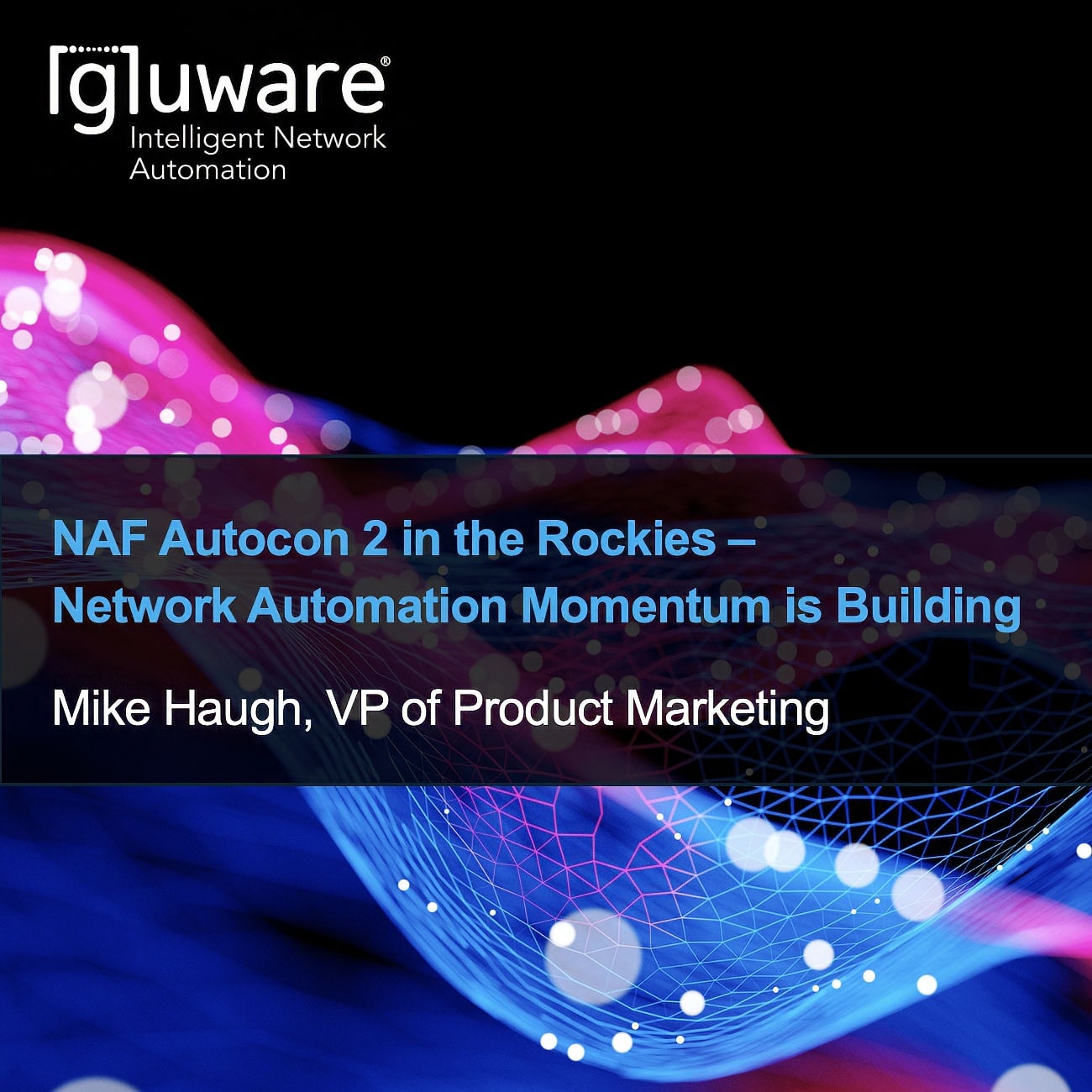By Michael Haugh, VP Product Marketing, Gluware
Introduction
The landscape of network automation is evolving rapidly, and nowhere is this more apparent than at the NAF Autocon 2 event. Following the excitement of Autocon 0, the inaugural event just a year ago, Autocon 2 has further solidified the growing momentum behind network automation. Professionals from various sectors gathered in the Rockies to exchange insights, share success stories, and discuss challenges, all pointing toward one undeniable fact: network automation is no longer a distant future—it’s here, and it’s advancing quickly.
From enterprise pioneers demonstrating robust end-to-end automation solutions to discussions on overcoming common organizational hurdles, this event highlighted both the potential and the realities of network automation adoption. Below are my top 10 takeaways, showcasing why network automation is becoming a cornerstone of modern IT strategies and how organizations can position themselves for success.
Top 10 Takeaways from Autocon 2
- Survey Data Shows Network Automation Gaining Traction
Chris Grundermann, NAF Co-founder, presented promising survey data from the 2024 State of Network Automation Survey showing year-over-year increases in the number of companies adopting automation, the percentage of network tasks being automated, and the variety of use cases being explored. These trends highlight a growing recognition of automation as a critical IT initiative. - Management Buy-In Remains a Challenge
Despite its importance, network automation often struggles to rank among management’s top five priorities. Enterprise presenter Matthew Deibel from Southern California Edison shared success stories advocating a “start small and show value” approach: implement automation that directly impacts business outcomes, then use those wins to build the case for broader organizational investment. - Build Influence Through Cross-Functional Collaboration
William Collins emphasized the power of forming alliances with cloud and security teams—two groups that typically enjoy more visibility and funding. Collaborative projects that align network automation with broader IT objectives can elevate the profile of networking teams and secure buy-in from leadership. - Diverging Capabilities: The ‘Haves’ vs. the ‘Have-Nots’
Organizations with dedicated development teams are achieving remarkable results, as seen in a presentation by Hari Gollapalli from PayPal. However, many enterprises lack such resources, often relying on engineers learning tools like Ansible and Python on the side. Bridging this gap remains a significant challenge. - The Open-Source Conundrum
Open-source tools are a common starting point for enterprises, offering flexibility and cost savings. However, the diversity and sprawl of available tools can be overwhelming, with successful implementations often requiring several tools working in tandem. Maintenance and scalability also pose ongoing concerns. Dave Hegenbarth presented a survey with EMA finding that using five tools led to the most success in automation. - The Critical Role of Data and Documentation
Automation is only as good as the data it relies on. Clean, centralized documentation and a “source of truth” system like NetBox are essential for managing network variables and ensuring consistent, reliable automation. Several presentations mentioned that having accurate data, documentation and methods for resource management are critical for network automation success. - Automation Beyond Configuration Changes
True network automation goes beyond configuration management to include tasks like monitoring, troubleshooting, auditing, and more. “Read-only” automation—automating tasks that don’t make changes to the network—is an excellent, low-risk way to begin the automation journey. Danny Wade presented on automating the testing of the network. Jose Miguel Izquierdo presented on automating reports and documentation. - You Don’t Have to Build Everything Yourself
While many enterprises start with open-source solutions, commercial tools can significantly accelerate progress. Vendors like Gluware demonstrated how their offerings help organizations evolve from basic tasks to full-scale automation, saving time and reducing complexity. Anna Claiborne highlighted in her opening keynote that vendors like Cisco contributed to the challenge of automation through the use of Command Line Interface (CLI). Gluware has helped solve this problem by providing a device interaction and automation layer (DIAL) that automates vendor CLI or API. - The ‘Buy, Borrow, Build’ Strategy
Jeremy Schulman shared a pragmatic framework for automation: buy commercial solutions when feasible, borrow open-source tools where they fit, and only build custom solutions when necessary. This balanced approach can help organizations avoid overextending their resources while achieving meaningful results. - AI is Transforming Network Automation
AI-driven solutions, particularly generative AI (GenAI) and chat-based interfaces, are already enhancing network automation workflows. From AI copilots in monitoring tools to ChatOps integrations, these technologies offer intuitive ways to interact with complex systems, accelerating efficiency and innovation. Jeremy Schulman, Du’An Lightfoot and Phillip Gervasi presentations each included how AI is beginning to transform network automation use cases.
Conclusion
NAF Autocon 2 highlighted a pivotal moment in the journey of network automation, underscoring both its immense potential and its present challenges. The message was clear: while the road to automation may require strategic planning, the benefits—enhanced efficiency, reduced errors, and improved agility—make the effort worthwhile.
As automation matures, integrating AI, leveraging cross-functional collaborations, and adopting strategic frameworks like “Buy, Borrow, Build” will be key drivers of success. Whether you’re just starting with open-source tools or exploring advanced commercial solutions, the time to act is now. With every step forward, the network automation community is building a foundation for a more efficient, resilient, and innovative IT future.
By reflecting on these takeaways and embracing the momentum, your organization can join the growing ranks of those leading the charge in the automation revolution. The future is automated—will you be part of it? Learn how Gluware can help you accelerate your network automation journey at https://gluware.com/

